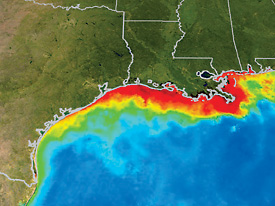Extreme flooding of the Mississippi River this spring is expected to result in the largest Gulf of Mexico “dead zone” on record, according to a U-M aquatic ecologist and his colleagues.
The 2011 forecast, released last week by the U.S. National Oceanic and Atmospheric Administration (NOAA), calls for a Gulf dead zone of between 8,500 and 9,421 square miles, an area roughly the size of New Hampshire.

The red and yellow areas show the approximate boundaries of a Gulf of Mexico dead zone from several years ago. U-M researchers predict a record dead zone this year due to mass flooding, says Donald Scavia, above, special counsel to the U-M president for sustainability, director of the Graham Sustainability Institute, and a professor at the School of Natural Resources and Environment. Photo by Courtesy NASA/Goddard Space Flight Center Scientific Visualization Studio.
The most likely 2011 scenario, according to U-M’s Donald Scavia, is a Gulf dead zone of at least 8,500 square miles, surpassing the current record of 8,400 square miles, set in 2002. The average over the past five years is about 6,000 square miles.
“Stream flows were nearly double normal during May, delivering massive amounts of nutrients to the Gulf, and that’s what drives the dead zone,” says Scavia, special counsel to the president for sustainability, director of the Graham Sustainability Institute, and a professor at the School of Natural Resources and Environment.
Farmland runoff containing fertilizers and livestock waste — some of it from as far away as the Corn Belt — is the main source of the nitrogen and phosphorus that cause the annual Gulf of Mexico oxygen-starved, or hypoxic, zone. Each year in late spring and summer, these nutrients flow down the Mississippi River and into the Gulf, fueling explosive algae blooms there.
When the algae die and sink, bottom-dwelling bacteria decompose the organic matter, consuming oxygen in the process. The result is an oxygen-starved region in bottom and near-bottom waters: the dead zone.
This year, stream-flow rates in the Mississippi and Atchafalaya Rivers were nearly double normal during May 2011, significantly increasing the amount of nitrogen and phosphorus transported by the rivers into the Gulf.
According to U.S. Geological Survey estimates, 164,000 metric tons of nitrogen were transported in May 2011 to the northern Gulf, off the Louisiana coast. The amount of nitrogen transported to the Gulf in May 2011 was 35 percent higher than average May nitrogen loads estimated in the last 32 years.
The amount of nitrogen entering the Gulf each spring has increased about 300 percent since the 1960s, mainly due to increased agricultural runoff, Scavia says.

Scavia. Photo by Martin Vloet, U-M Photo Services.
“Yes, the floodwaters really matter, but the fact that there’s so much more nitrogen in the system now than there was back in the ’60s is the real issue,” he says. Scavia’s computer model suggests that if today’s floods contained the level of nitrogen from the last comparable flood, in 1973, the predicted dead zone would be 5,800 square miles rather than 8,500.
“The growth of these dead zones is an ecological time bomb,” Scavia says. “Without determined local, regional and national efforts to control them, we are putting major fisheries at risk.” The Gulf of Mexico/Mississippi River Watershed Nutrient Task Force has set the goal of reducing the size of the dead zone to about 1,900 square miles.
In 2009 the dockside value of commercial fisheries in the Gulf was $629 million. Nearly 3 million recreational fishers further contributed more than $1 billion to the Gulf economy, taking 22 million fishing trips.
The Gulf hypoxia research team is supported by NOAA’s Center for Sponsored Coastal Ocean Research and includes scientists from U-M, Louisiana State University and the Louisiana Universities Marine Consortium. NOAA has funded investigations and forecast development for the dead zone in the Gulf of Mexico since 1990.
“While there is some uncertainty regarding the size, position and timing of this year’s hypoxic zone in the Gulf, the forecast models are in overall agreement that hypoxia will be larger than we have typically seen in recent years,” says NOAA Administrator Jane Lubchenco.
The actual size of the 2011 Gulf hypoxic zone will be announced following a NOAA-supported monitoring survey led by the Louisiana Universities Marine Consortium between July 25 and Aug. 2.

